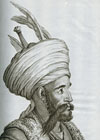Persia from a Western Perspective
 The Academy library has several interesting studies about Persia, especially seventeenth and eighteenth-century historiographies and travel and country descriptions: Persia from that period and Persian history from a European perspective. The IISH is exhibiting a small selection from this collection.
The Academy library has several interesting studies about Persia, especially seventeenth and eighteenth-century historiographies and travel and country descriptions: Persia from that period and Persian history from a European perspective. The IISH is exhibiting a small selection from this collection.
For centuries, travelling from East to West meant undertaking journeys filled with deprivation that could last months and even years. Prior to the voyages of discovery by ships, very few succeeded in completing such journeys. The best-known examples from Antiquity and the Middle Ages include Alexander the Great, who travelled to India in the fourth century B.C.E., and the Venetian salesman Marco Polo, who journeyed across Asia in the thirteenth century.
In the East lay not only the Holy Land. There, and especially further afield, unknown distant venues beckoned. In addition to appealing to people's desire to travel and piquing their curiosity, they stimulated their imagination. Previous travellers told of fairy-tale like settings, enchanting palaces, spirits, gods, and jinns, magic lamps, and incredible adventures. Distinguishing truth from fantasy became virtually impossible.
Printed travel reports grew increasingly popular from around the seventeenth century onward. Many featured illustrations added in the traveller's country of origin to enhance their appeal. In most cases these illustrations were based on the text, but since reliable visual sources were rare to non-existent, these travel accounts conveyed fantasies rather than a realistic impression of the Far East.
Journeys undertaken for trade or conquests or to disseminate Christianity regularly led to confrontations and in some cases to violent clashes. In the seventeenth century, Persia was known primarily for silk exports. As a monopoly of the Shah, exports were a source of conflicts with foreign merchants, who did not wish to miss out on this lucrative trade.
In the seventeenth and eighteenth centuries many reports were published about journeys across Persia, initiated not only by trading companies but also by individuals relating their personal experiences and impressions. These journeys were personal initiatives or commissioned by wealthy individuals with special interests, such as vegetation and wildlife or the political situation in a certain area.
The IISH is pleased to present this small selection from the Persia studies collection, including works by the English Orientalist George Sale (ca. 1696-1736), such as a translation of the Koran (1734) republished several times, and by the English historian and Arabist Simon Ockley (1678-1720). Ockley published a Persian historiography. Though somewhat lacking in accuracy - the work reads more like a collection of stories than a proper historiography - its literary quality is excellent. The Frenchman Louis-Matthieu Langlès (1763-1824), an Arabist and the first president of the École spéciale des Langues Orientales in Paris, translated L'instituts politiques et militaires de Tamerlan by the Mongolian warrior Tamerlane (1336-1405) into French. Other items include dictionaries and travel reports, for example by Jean Baptiste Tavernier (1605-1689), Jan Janszoon Struys (1630- after 1694) and Cornelis de Bruin (1652-1727).
